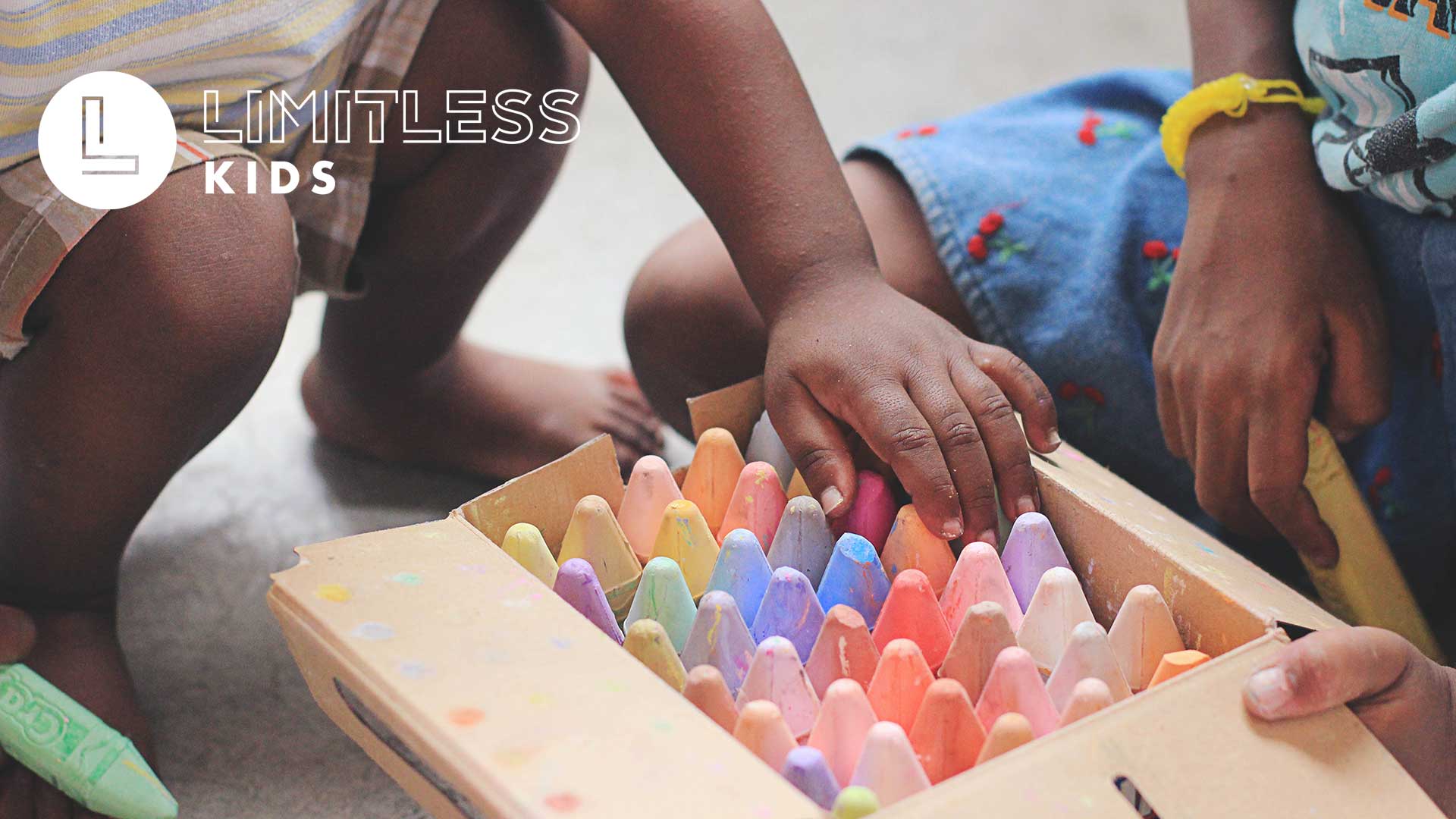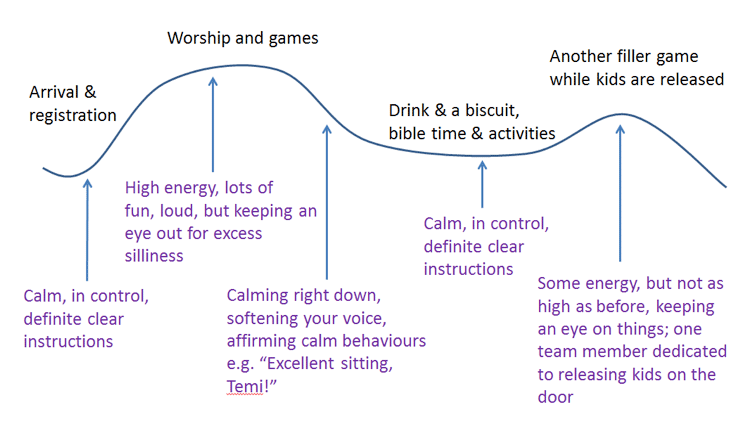
How do you create a good children's ministry session every week?
In this article, Nick Whittome seeks to equip children's ministry leaders with some helpful and intentional approaches to creating a strong structure for each week's session. These sessions are designed for the children to thrive, have fun and grow spiritually.
It really helps if children's ministry teams know how to create orderly environments for children. Children feel more safe and settled, and leaders and teams feel more in control. Spiritual receptiveness is greatly facilitated by a good session structure.
Rooms that are chaotic are no fun for anyone, and can even become dangerous, with the possibility of bumped heads and the like.
This guideline helps leaders to be aware of some different components via which ministry teams can control the room well and have a helpful structure.
1. Be Calm & Orderly Yourself
Children pick up on how we are, and they reflect that.
If we are calm and orderly, as a default pattern of character and behaviour, that will help you greatly.
If you are stressy and chaotic, then it will harder for you to create order in the children, as they are not seeing it modelled by you.
To bring order, stand calmly and use some loudly-clapped rhythms the children can copy. Alternatively, wait with a hand up for quiet.
Trying to say “Sshh!” loudly, or “Guys, guys!” is not very effective.
2. Plan and Lead the ‘Energy Profile’
As a leader, you are responsible for directing the energy levels in the room for a kids ministry session.
Below is a typical ‘energy profile’ that works for most age ranges of children from Year 2 to Year 6.
The energy profile line climbs for high action and exciting times and comes back down again for when you need it to be more quiet and orderly.
The black text above refers to a typical sequence for a children’s ministry session; the purple text below refers to a typical approach in a room leader’s mind to the energy of the room.

It is important that you understand three things about “energy profile”:
-
It is a gradual intentional curve from one type of energy into another, which you are responsible for introducing and leading, from one phase to the next.
-
It’s unrealistic to expect kids to go instantly from one to another – you have to migrate them over from one phase to another during the session and set expectations along the way.
-
A session which has all of only one kind of energy will be very difficult for everyone i.e. all sitting quietly is not fair to children because they need to use up energy. In fact, they will be harder to manage if you try to force them to endure a calm profile all the time. Bear in mind too that children may well have already been sitting or standing upstairs without using up lots of energy before they come to their ministry.

3. Embrace the Energy Rather Than Fight it!
Following on from the last point, rather than fight the need for children to express their abundant energy, channel it!
Have sessions of dance and worship to begin with, and active games where they can move about, to express their energy.
Another great and hugely fun way to do this for everyone has moments when all the children have to jump up and doing something very energetic and silly all together, and then all suddenly sit down again. Keep these more to the front end of your session, when you are intentionally having a time of higher energy.
These moments can be signalled by a particular word, action or piece of music so that when this happens, all the children know they have to do something together.
For this to work, you need to teach the children what they need to do; and you need to practice it a few times.
For example, you could say: “Every time you hear the word Jesus in this story, you need to jump up as high as you can where you are, and then hit the deck again as quick as you can.”
When it’s a competition to all sit down as quick as you can at the end of that, you have combined high energy output in them, with back to orderliness straight after again.
The kids are listening out carefully for the word, but they are also burning energy – win/win.
4. Be the Adult in Charge
We do not have to always be popular with all the children all the time.
Sometimes it is necessary to be definite and firm – and that may mean that you could temporarily be unpopular.
Good parenting sometimes means needing to be a bit unpopular, as you set boundaries, and it’s no different in children’s work.
It can be helpful if you develop a ‘discipline’ person on the team.
This allows you to continue to lead the room, whilst the child who might be being difficult is taken to one side, and they have a little one-to-one chat that is gentle but also definite.
If this is necessary, here are some guidelines if you need to be the ‘discipline’ person:
-
Take a child individually off to one side (but always remain in view) and allow other members of the team to lead the rest of the children for a few minutes
-
Get down to their level, so your eyes are at the same height as theirs.
-
Always keep a calm low voice, and be kind, gentle but definite.
-
Quietly ask if they are OK. Often poor behaviour has a root – e.g. being picked on that week at school.
-
Remind them of the rules, and explain gently and clearly how they are violating them.
-
Ask them to sit next to you for a minute, to defuse tensions and change energy.
-
Perhaps ask them to help you with a little job e.g. collecting up cups, organising the crayons, loading the YouTube video – but keep close supervision if you try this, and only if you think they are able to do the job. This can be quite effective in re-directing them. Re-direction is such a powerful help in leading children into different and better behaviour.
-
If all else fails, you can ask the child if they would like to be returned to their parents. If you or they want this, text the parent mobile (you need to ensure this is a part of your register or walk with the child to find their parent).
-
Never shout individually at a child – although sometimes you may need to raise your voice to be heard in a room.
-
Never smack a child, although you may have to restrain them carefully if they are lashing out, to protect others or yourself.
These measures nearly always work, but it must be said they are also harder to achieve in an under-resourced team where there isn’t the spare capacity of leaders. This is why it is so important that kids’ teams are very reliable in showing up.
Always make a point of letting the parents know afterwards there were some difficulties during the session with a particular child – they need to hear about it, and they may potentially offer some insights into why.
If a child goes into a complete tantrum or meltdown, it could be appropriate either to evacuate the children to another room, if that is viable; or call for some extra help – or both. Definitely engage the parents about this, if this happens.
5. Have Definite Room Rules
It is always a good idea to have about 5 definite rules, which states in simple kid-friendly language, what it is that you want the kids to know about behaviour.
Recite these from a PowerPoint every time you run a session, or have these around your children's ministry room.
You can create these rules yourself, and use them to shape the expectations about how we all behave in the room.
There is absolutely no problem repeating rules aloud together each and every session. In fact, this is a great idea.
Kids enjoy definiteness and repetition; and when we have new children arriving, it helps them to get to know how things are done as they join.
Over several weeks, you can begin to ask individual children to tell everyone what a particular rule is.
With a twinkle in your eye and a definite loud voice, tell the whole room: “I’m looking for a child sitting with a nice straight back, a big smile, legs crossed and ready to tell me our first rule!”
Affirm 3 or 4 children sitting really well.
Then pick someone to say out a rule – and encourage them if they do it well. Prompt them if they forget or stumble i.e. don’t make them feel bad for not remembering or being overcome with shyness.
I would include special rules for the Bible, teaching and prayer time of no going to the toilet or getting drinks. These would be extra to the main rules, so they all stay in the room and stay really attentive to one of the really important parts of the session.
Sample Room Rules
-
Pay attention to the leader
-
Be kind to everyone
-
Join in
-
No going to the toilet during bible and prayer time
-
Have fun!

6. Pay Attention to the Overall Structure & Room Environment
Think carefully about the structure of your session. What we mean by this is that you plan what you are going to do and when in the sequence of the session; and you also pay close attention to how the room is set up.
If you walk children into a room which has balloons or plastic footballs lying around all over the floor, you will have a much, much harder time bringing things to order that if there are just 3 balloons as part of team game which are out of sight as the children arrive, but which are then brought out just when they are needed.
There should be nothing in the room which is a distraction – and kids have great imaginations, so they will turn anything into a means to play!
If you don’t want kids playing with it, remove it or hide it. You are not being deceitful – you are creating a helpful structure.
As part of the structure, consider group dynamics as well. If you need kids to sit behind a line, mark that line out with gaffer tape on the floor in advance. If they need to be in teams, mark out the places for their teams really clearly. If you need to do registration easily, create a large rectangle out of tape on the floor that they have to jump into once their name is called out.
If fidgeting and nudging one another are a problem, give them all a sample carpet tile to sit on, and then ask them to keep their hands and feet to their own carpet tile. It’s fun watching them try to achieve this! (Most carpet stockists just throw these out).
A lot of problems with the order in a room are because the adult in charge has simply not taken into account the lively and imaginative nature of children. Most children are happy to play with a slope and a big cardboard box, so it is just unfair for us to expect them not to try and play with anything they see.
Another great idea with structure is that kids sat down can’t run about causing mayhem. When their part of a team game finishes, get kids to hit the deck, to show they are finished – but also so that they stop moving around the room, and are in one place.
Pay attention to times when you are asking them to move, so that they are all moving together in one direction, e.g. all clockwise. A room full of children running in different directions or across each other is asking for an accident to happen!
7. How Games Need to Work
One aspect of games that is often neglected is that they need to be inclusive.
Non-inclusive games all by itself can lead to disorderly behaviour.
Games which whittle the participants slowly down to one winner in a room of 40 children are usually not helpful, for three reasons:
-
You are creating an increasing group of children who are slightly unhappy because they are now ‘out’ and have not won.
-
This group who are ‘out’ are obliged to watch others who are still ‘in, which isn’t that fun.
-
This group who are ‘out’ are also are unlikely to have anything fun to do themselves. Expecting children to stand out graciously and wait is asking too much.
Always aim for team games, so that everyone can join in and take a turn.
That also lends itself to collective winning, rather just super-talented or confident individuals always getting the spotlight. Children will usually naturally wait to take their turn quite well if they are in a relay. They won’t wait well if there is no apparent incentive about to appear. So keep the turnover of the game quick. Use more and smaller teams if possible.
Using Incentives During Games
You can help create order during games through the incentive of points and also disincentives of team balloons being popped.
Points in Games (and beyond)
Develop a system of teams winning points in each game you run – and write these on a flipchart or whiteboard. You would need to split your kids into two or three teams for this – and this is where masking taped boxes on the floor space are helpful because you can create one for each team.
This is helpful for order, because a team dynamic self-regulates (slightly, but not always!), and team members can often naturally just encourage one another to participate.
Be fair in your allocation of points, and add them up as you go along. I would avoid carrying points totals from session to session because some kids have fabulous memories and will hold you to account for not caring enough about the actual score from last time! Each children's work session can result in a team win.
You can extend awarding points for all sort of things, outside games, if you like: great sitting; first team to sit down at the end; team member who remembers a whole memory verse; team that wins their game and sits down first at the end; a great contribution to the discussion, etc.
Using Disincentives
If you do decide to lead your children’s ministry in teams, consider having a group of 3 coloured balloons at the front of each team, colour-coded for each team. After you have gone through your team rules, then explain that you will warn the children once about behaviour; and then after that, there will be a balloon popped by the room leader. If all three balloons are popped, all team points might go to zero again.
The behaviour usually sorts itself quite quickly after a balloon is popped, as is it is quite a shock – kids can sit there stunned that you just did it!
Bear in mind, however, that some kids are not motivated in the slightest about whether the rest of the children in their time are trying to persuade them to be good; and will actually enjoy the drama of the balloon-popping. If this is the case, there could be a case for a leader to ‘chaperone’ this kind of child individually.
8. Toilet Runs
Younger children need to be accompanied to the toilet by a DBS-cleared adult. It makes sense to take groups together. This why we often need 3 or 4 helpers for younger ministries (Nursery, Reception, Year 1).
Older children (Year 2-6) can take themselves. I would recommend you set them a time limit of 1 minute to keep the focus on returning quickly, and only allow one child out at a time (as often a toilet run is an excuse to have time away or “be special” that isn’t really needed). Having only one kid out at once also avoids groups congregating in toilets. Clearly, if a kids need to go, they need to go.
I would also make a room rule for no toilet during bible or prayer time, to set the expectation that your carefully prepared time is not constantly disrupted.
Nick Whittome is married to Chloe, and dad to 3 boys: George, Simon and Adam. He is an assistant pastor at Birmingham City Church with leadership oversight for children’s ministry that sees anything up to 180 kids through the doors each week. Nick has been leading and helping in a wide range of kids ministries since 2007 after he got persuaded to help at an after-school kids club and found it way more fun than he thought it would be!
Join the Children's Worker track at ELS19
Send your children's workers to ELS19 and join the Children's Worker Track. There are 100 free places available for first timers with 2 free tickets available for each Elim church. Limited availability. Exclusions & terms apply.* See elimleaders.org.uk

Enjoy this article? Don't forget to share